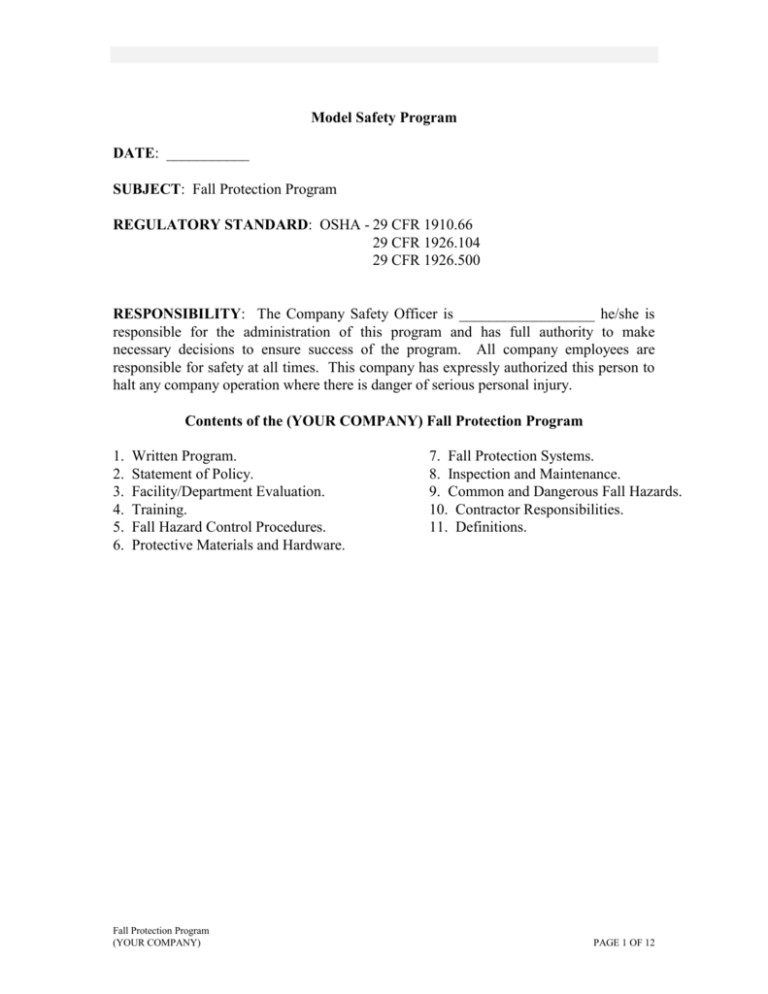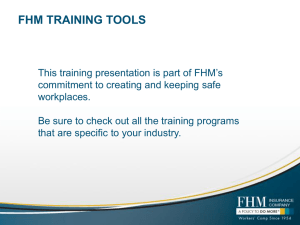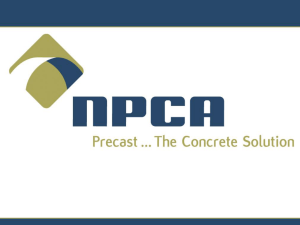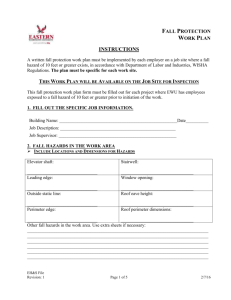Word
advertisement

Model Safety Program DATE: ___________ SUBJECT: Fall Protection Program REGULATORY STANDARD: OSHA - 29 CFR 1910.66 29 CFR 1926.104 29 CFR 1926.500 RESPONSIBILITY: The Company Safety Officer is __________________ he/she is responsible for the administration of this program and has full authority to make necessary decisions to ensure success of the program. All company employees are responsible for safety at all times. This company has expressly authorized this person to halt any company operation where there is danger of serious personal injury. Contents of the (YOUR COMPANY) Fall Protection Program 1. 2. 3. 4. 5. 6. Written Program. Statement of Policy. Facility/Department Evaluation. Training. Fall Hazard Control Procedures. Protective Materials and Hardware. Fall Protection Program (YOUR COMPANY) 7. Fall Protection Systems. 8. Inspection and Maintenance. 9. Common and Dangerous Fall Hazards. 10. Contractor Responsibilities. 11. Definitions. PAGE 1 OF 12 (YOUR COMPANY) Fall Protection Program 1. Written Program. The company will review and evaluate this standard practice instruction: On an annual basis When changes occur to 29 CFR, that prompt revision of this document When facility operational changes occur that require a revision of this document When there is an accident or close-call that relates to this area of safety Review the program any time fall protection procedures fail Effective implementation of this program requires support from all levels of management within this company. This written program will be communicated to all personnel that are affected by it. It encompasses the total workplace, regardless of the number of workers employed or the number of work shifts. It is designed to establish clear goals, and objectives. 2. Statement of Policy. The hazards of potential falls at heights of 6 feet and above will be addressed in this document. This instruction describes a systematic approach that must be used to protect and prevent people from falling. This instruction also lists some of the most common fall hazards, and provides recommendations and guidelines for selecting fall arrest systems. 3. Facility/Department Evaluation. The workplace will be assessed before each assigned job for potential fall hazards. Proper fall arrest equipment will be used for jobs requiring fall protection when elimination of the hazard(s) is not possible. This company will evaluate the facilities by department to determine fall hazards. This preliminary evaluation will detail the required steps for protecting employees from fall hazards. A fall hazards assessment sheet (see appendix) will be used to document fall hazard assessments. A complete list of fall hazard locations and protective measures procedures will be maintained. Fall Hazard Location List Department _________________ _________________ _________________ _________________ _________________ _________________ _________________ _________________ Fall Protection Program (YOUR COMPANY) Specific Fall Hazard Location _______________________ _______________________ _______________________ _______________________ _______________________ _______________________ _______________________ _______________________ Date Evaluated _________________ _________________ _________________ _________________ _________________ _________________ _________________ _________________ Remarks ___________ ___________ ___________ ___________ ___________ ___________ ___________ ___________ PAGE 2 OF 12 4. Training. A training program will be provided for all employees who will be exposed to fall hazards in the work area, and will be conducted by competent personnel. The program will include but will not be limited to: A description of fall hazards in the work area Procedures for using fall prevention and protection systems Equipment limitations The elements encompassed in total fall distance Prevention, control and fall arrest systems Inspection and storage procedures for the equipment Generally, workers will be trained to recognize the hazards of falling from elevations and to avoid falls from grade level to lower levels through holes or openings in walking/working surfaces. Training programs will include prevention, control and fall arrest systems. It must be ensured that appropriate fall arrest systems are installed, and that employees know how to use them before beginning any work that requires fall protection. 4.1 Initial training. Training will be conducted prior to job assignment. This employer will provide training to ensure that the purpose, function, and proper use of fall protection is understood by employees and that the knowledge and skills required for the safe application, and usage is acquired by employees. This standard practice instruction will be provided to, and read by all employees receiving training. The training will include, as a minimum the following: 4.1.1 Types of fall protection equipment appropriate for use. 4.1.2 Recognition of applicable fall hazards associated with the work to be completed and the locations of such. 4.1.3 Load determination and balancing requirements. 4.1.4 Procedures for removal of protection devices from service for repair or replacement. 4.1.5 All other employees whose work operations are or may be in an area where fall protection devices may be utilized, will be instructed to an awareness level concerning hazards associated with fall protection operations. 4.1.6 Fall protection equipment identification. Fall protection equipment having identification numbers will be checked for legibility. Fall protection equipment having illegible identification markings will be turned in to the supervisor for inspection. 4.1.7 Equipment maintenance and inspection requirements. Fall Protection Program (YOUR COMPANY) PAGE 3 OF 12 4.1.8 Equipment donning and doffing procedures. 4.1.9 Equipment strengths and limitations. 4.1.10 Certification. This employer will certify that employee training has been accomplished and is being kept up to date. The certification will contain each employee's name and dates of training. Training will be accomplished by competent personnel. 4.2 Refresher training. This standard practice instruction will be provided to, and read by all employees receiving refresher training. The training content will be identical to initial training. Refresher training will be conducted on a semi-annual basis or when the following conditions are met, whichever event occurs sooner. 4.2.1 Retraining will be provided for all authorized and affected employees whenever (and prior to) a change in their job assignments, a change in the type of fall protection equipment used, or when a known hazard is added to the work environment which affects the fall protection program. 4.2.2 Additional retraining will also be conducted whenever a periodic inspection reveals, or whenever this employer has reason to believe, that there are deviations from or inadequacies in the employee's knowledge or use of fall protection equipment or procedures. 4.2.3 Whenever a fall protection procedure fails. 4.2.4 The retraining will reestablish employee proficiency and introduce new or revised methods and procedures, as necessary. 4.2.5 Certification. This employer will certify that employee training has been accomplished and is being kept up to date. The certification will contain each employee's name and dates of training. Training will be accomplished by competent personnel. 5. Fall Hazard Control Procedures (Fall Prevention). 5.1 Control Procedures Development. Once a facility evaluation has been accomplished, procedures will be developed, documented and utilized for the control of potential fall hazards. Fall prevention plans will be designed by company competent individuals or other competent personnel. Company engineers (where utilized) or other competent personnel will be provided with any required specialized training to recognize fall hazards, to understand and address fall prevention techniques, and to become familiar with fall arrest equipment and procedures. It is critical that they consider fall protection design Fall Protection Program (YOUR COMPANY) PAGE 4 OF 12 for the safety of operations where employees must work at elevated heights. Safety during access and egress from elevated work sites will also be considered. The following guidelines will be used when planning work at elevated heights: - Involve the Safety Department early in the project planning/job planning so that they can recommend appropriate fall-protection measures and equipment. - Involve qualified Engineers when load rating of anchorage points must be determined or is in doubt. Required training will be provided as necessary. - Involve Engineering and Maintenance when anchorage points must be installed. - The Safety Officer and Engineering Departments will use the expertise of fall protection equipment manufacturers such as Rose Manufacturing Company., Miller Equipment Company, Research and Trading Company and DBI/SALA. - This Company will be specific in dealing with fall hazards when developing contracts. Contractors will be required to provide a written fall protection program which describes the Contractors’ fall protection policies and procedures when they will be working at elevated heights. 5.2 Procedural Format. The following format will be followed when developing fall protection procedures. The Safety Officer will be responsible for the implementation of these procedures. The procedures will clearly and specifically outline the scope, purpose, authorization, rules, and techniques to be utilized to control fall hazards, and the means to enforce compliance including, but not limited to, the following: 5.2.1 A specific statement of the intended use of the procedure. 5.2.2 A review of accident records, including OSHA 300 logs and Workers’ Compensation documentation. 5.2.3 Interviews with employees and groups of employees whose work environment includes or may include fall hazards. 5.2.4 Physical observations of the work environment(s) that involve fall hazards or the potential of such. 5.2.5 Observations of individuals and their job tasks and work habits that expose them to existing or potential fall hazards. 5.2.6 The procedures contained in the company fall protection program. Fall Protection Program (YOUR COMPANY) PAGE 5 OF 12 5.2.7 Specific procedural steps for the use and operation of body harness systems, and other fall protection systems. 5.2.8 Specific procedural steps for the placement, erection, inspection, maintenance, disassembly and transfer of fall protection systems or devices and the person(s) responsible for them. 5.2.9 Specific requirements for testing fall protection systems or equipment to determine and verify the effectiveness of the fall protection control measures (not load testing). 5.2.10 The correct procedures to rescue employees who have fallen. 5.2.11 The role of each employee in fall protection plans and applicable policies. 5.2.12 Specific requirements for testing fall protection systems or equipment. 6. Protective Materials and Hardware. Appropriate fall protection devices will be provided for potential fall hazards. Selection of the equipment will be based on the fall protection evaluation. Evaluations will be conducted by the following personnel authorized to evaluate fall protection requirements: 1. 2. 3. 4. 5. 6. Duty Title ____________________________________________________________ ____________________________________________________________ ____________________________________________________________ ____________________________________________________________ ____________________________________________________________ ____________________________________________________________ 6.1 Selection Criteria. 6.1.1 Fall Protection devices will be singularly identified; will be the only devices(s) used for controlling falls; will not be used for other purposes; and will meet the following requirements: 6.1.1.1 Capable of withstanding the environment to which they are exposed for the maximum period of time that exposure is expected. 6.1.1.2 Anchor points will not deteriorate when located in corrosive environments such as areas where acid and alkali chemicals are handled and stored. Fall Protection Program (YOUR COMPANY) PAGE 6 OF 12 6.1.1.3 Capable of withstanding the ultimate load of 5,000 lbs. for the maximum period of time that exposure is expected. 6.1.1.4 Standardization within company facilities. Fall protection devices will be standardized whenever possible. 7. Fall Protection Systems. When fall hazards cannot be eliminated through any other means, fall arrest systems will be used to control falls. Proper training on the use of fall arrest equipment is essential and will be provided prior to use. 7.1 Full Body Harness Systems. A full body harness system consists of a full-body harness, lanyard, energy shock absorber, and self-locking snap hook. Before using a full-body harness system, the supervisor and/or the user must address such issues as: 7.1.1 Has the user been trained to recognize fall hazards and to use fall arrest systems properly? 7.1.2 Are all components of the system compatible according to the manufacturer’s instructions? 7.1.3 Have appropriate anchorage points and attachment techniques been reviewed? 7.1.4 Has free fall distance been considered so that a worker will not strike a lower surface or object before the fall is arrested? 7.1.5 Have swing fall hazards been eliminated? 7.1.6 Have safe methods to retrieve fallen workers been planned? 7.1.7 Has the full-body harness and all of its components been inspected both before each use and on a regular semi-annual basis? 7.1.8 Is any of the equipment, including lanyards, connectors, and lifelines, subject to such problems as welding damage, chemical corrosion, or sandblasting operations? 7.2 Retractable Lifelines 7.2.1 A retractable lifeline is a fall arrest device used in conjunction with other components of a fall arrest system. Retractable lifelines should be used by one person at a time. Fall Protection Program (YOUR COMPANY) PAGE 7 OF 12 7.2.2 A properly inspected and maintained retractable lifeline, when correctly installed and used as part of the fall arrest system, automatically stops a person’s descent in a short distance after the onset of an accidental fall. 7.2.3 Retractable lifelines may be considered when working in areas such as on roofs and scaffolds, or in tanks, towers, vessels, and manholes. Also, retractable lifelines should be considered when climbing such equipment as vertical fixed ladders. Before using a retractable lifeline, the supervisor and/or the user must address the following questions: 7.2.3.1 Has the user been trained to use a retractable lifeline correctly? 7.2.3.2 Is the retractable lifeline being used in conjunction with a complete fall arrest system? 7.2.3.3 Is the equipment under a regular maintenance program? 7.2.3.4 Has the equipment been inspected within the last six months? 7.3 Standard Harnesses. Harnesses for general purpose work should be Class III, constructed with a sliding back D-ring. Standard harnesses are suitable for continuous fall protection while climbing, riding, or working on elevated personnel platforms. They are suitable for positioning, fall arrest, and the rescue and evacuation of people who are working at elevated heights. 8. Inspection and Maintenance. To ensure that fall protection systems are ready and able to perform their required tasks, a program of inspection and maintenance will be implemented and maintained. The following as a minimum, will comprise the basic requirements of the inspection and maintenance program: 8.1 Equipment manufacturer’s instructions will be incorporated into the inspection and preventive maintenance procedures. 8.2 All fall protection equipment will be inspected prior to each use, and a documented inspection at intervals not to exceed 6 months, or in accordance with the manufacturers guidelines. 8.3 The user will inspect his/her equipment prior to each use and check the inspection date. 8.4 Any fall protection equipment subjected to a fall or impact load, will be removed from service immediately and inspected by a qualified person (sent back to the manufacturer). 8.5 Check all equipment for mold, damage, wear, mildew, or distortion. Fall Protection Program (YOUR COMPANY) PAGE 8 OF 12 8.6 Hardware should be free of cracks, sharp edges, or burns. 8.7 Ensure that no straps are cut, broken, torn or scraped. 8.8 Special situations such as radiation, electrical conductivity, and chemical effects will be considered. 8.9 Equipment that is damaged or in need of maintenance will be tagged as unusable, and will not be stored in the same area as serviceable equipment. 8.10 A detailed inspection policy will be used for equipment stored for periods exceeding one month. 8.11 Anchors and mountings will be inspected before each use by the user and supervisor for signs of damage. 9. Most Common and Most Dangerous Fall Hazards. The tasks and situations listed below present inherent fall hazards. Give special attention to providing fall prevention and/or fall control for them, remembering that this attention is necessary in the design, engineering, planning, and execution stages of work. Supervisors will give special consideration to fall protection for the following tasks: 9.1 Working from crane booms and tower cranes. 9.2 Working on top of machinery and equipment, such as overhead cranes, furnaces, conveyors and presses. 9.3 Other work that involves fall hazards, such as ‘off-chutes’ from main piping in duct work or boilers. 9.4 Working on roofs, with deteriorating or unsupported sections and framing. 9.5 Working over chemical tanks or open pits. 9.6 Working from a fixed or portable ladders, or climbing systems. 9.7 Performing work on water towers, product tanks, silos, pipe racks, presses, and floor pits. 10. Contractor Responsibilities. In addition to complying with the fall protection requirements that apply to all company employees, each contractor who is retained to perform operations that involve fall protection will: 10.1 Obtain any available information regarding fall hazards and protective measures from this company. Fall Protection Program (YOUR COMPANY) PAGE 9 OF 12 10.2 Coordinate fall protection operations with the company, when both company personnel and contractor personnel will be working in or near recognized fall hazard locations. 10.3 Inform the company of the fall protection program that the contractor will follow and of any hazards confronted or created in conducting operations involving fall protection within company owned facilities through a debriefing immediately prior to the operation. 11. Definitions Anchorage means a secure point of attachment for lifelines, lanyards or deceleration devices. Body belt means a strap with means both for securing it about the waist and for attaching it to a lanyard, lifeline, or deceleration device. Body harness means straps which may be secured about the employee in a manner that will distribute the fall arrest forces over at least the thighs, pelvis, waist, chest and shoulders with means for attaching it to other components of a personal fall arrest system. Competent person means a person who is capable of identifying hazardous or dangerous conditions in any personal fall arrest system or any component thereof, as well as in their application and use with related equipment. Connector means a device which is used to couple (connect) parts of the personal fall arrest system and positioning device systems together. It may be an independent component of the system, such as a carabiner, or it may be an integral component of part of the system. Deceleration device means any mechanism with a maximum length of 3.5 feet, such as a rope grab, ripstitch lanyard, tearing or deforming lanyards, self-retracting lifelines, etc. which serves to dissipate a substantial amount of energy during a fall arrest, or otherwise limit the energy imposed on an employee during fall arrest. Energy shock absorber means a device that limits shock-load forces on the body. Failure means load refusal, breakage, or separation of component parts. Load refusal is the point where the ultimate strength is exceeded. Fall arrest system means a system specifically designed to secure, suspend, or assist in retrieving a worker in or from a hazardous work area. The basic components of a fall arrest system include anchorage, anchorage connector, lanyard, shock absorber, harness, and self-locking snap hook. Fall Protection Program (YOUR COMPANY) PAGE 10 OF 12 Free fall means the act of falling before a personal fall arrest system begins to apply force to arrest the fall. Free fall distance means the vertical displacement of the fall arrest attachment point on the employee’s body belt or body harness between onset of the fall and just before the system begins to apply force to arrest the fall (maximum of 6 feet). This distance excludes deceleration distance, and lifeline/lanyard elongation, but includes any deceleration device slide distance or self-retracting lifeline/lanyard extension before they operate and fall arrest forces occur. Hole means a gap or void 2 inches or more in its least dimension, in a floor, roof, or other walking/working surface. Lanyard means a flexible line of rope, wire rope, or strap which generally has a connector at each end for connecting the body belt or body harness to a deceleration device, lifeline or anchorage. Leading edge means the edge of a floor roof, or formwork for a floor or other walking/working surface which changes location as additional floor, roof, decking, or formwork sections are placed, formed or constructed. A leading edge is considered to be an unprotected side and edge during periods when it is not actively and continuously under construction. Lifeline means a component consisting of a flexible line for connection to an anchorage at one end to hang vertically or for connection to anchorages at both ends to stretch horizontally and which serves as a means for connecting other components of a personal fall arrest system to the anchorage. Opening means a gap or void 30 inches or more high and 18 inches or more wide, in a wall or partition, through which employees can fall to a lower level. Personal fall arrest system means a system used to arrest an employee in a fall from a working level. It consists of an anchorage, connectors, a body belt or body harness and may include a lanyard, deceleration device, lifeline, or suitable combinations of these. As of January 1, 1998, the use of a body belt for fall arrest is prohibited. Positioning device system means a body belt or body harness system rigged to allow an employee to be supported on an elevated vertical surface, such as a wall, and work with both hands free while leaning. Qualified person means one with a recognized degree or professional certificate and extensive knowledge and experience in the subject field who is capable of design, analysis, evaluation and specifications in the subject work, project, or product. Fall Protection Program (YOUR COMPANY) PAGE 11 OF 12 Retractable lifeline means a fall arrest device that allows free travel without slack rope, but locks instantly when a fall begins. Rope grab means a deceleration device which travels on a lifeline and automatically, by friction, engages the lifeline and locks so as to arrest the fall of an employee. A rope grab usually employs the principle of inertial locking, cam/level locking, or both. Safety-monitoring system means a safety system in which a competent person is responsible for recognizing and warning employees of fall hazards. Self-retracting lifeline/lanyard means a deceleration device containing a drum-wound line which can be slowly extracted from, or retracted onto, the drum under slight tension during normal employee movement, and which, after onset of a fall, automatically locks the drum and arrests the fall. Snaphook means a connector comprised of a hook-shaped member with a normally closed keeper, or similar arrangement, which may be opened to permit the hook to receive an object and, when released, automatically closes to retain the object. Snaphooks are generally one of two types: - The locking type with a self-closing , self-locking keeper which remains closed and locked until unlocked and pressed open for connection or disconnection; or - The non-locking type with a self-closing keeper which remains closed until pressed open for connection or disconnection. As of January 1, 1998, the use of a non-locking snaphook as part of personal fall arrest systems and positioning device systems is prohibited. Toeboard means a low protective barrier that will prevent the fall of materials and equipment to lower levels and provide protection from falls for personnel. Walking/Working surface means any surface, whether horizontal or vertical on which an employee walks or works, including, but not limited to, floors, roofs, ramps, bridges, runways, formwork and concrete reinforcing steel but not including ladders, vehicles, or trailers, on which employees must be located in order to perform their job duties. Warning line system means a barrier erected on a roof to warn employees that they are approaching an unprotected roof side or edge, and which designates an area in which roofing work may take place without the use of guardrail, body belt, or safety net systems to protect employees in the area. Work area means that portion of a walking/working surface where job duties are being performed. Fall Protection Program (YOUR COMPANY) PAGE 12 OF 12







